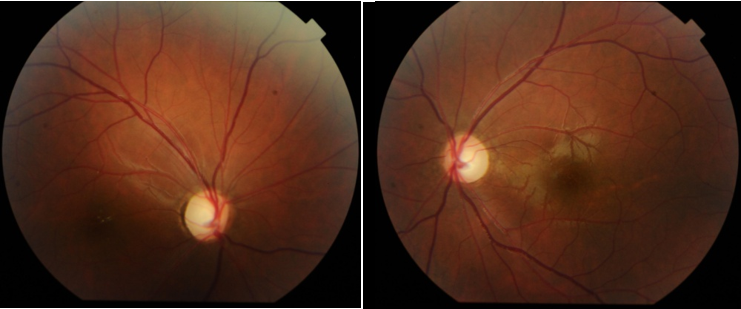Case Report
Volume 3 Issue 1 - 2021
Wolfram Syndrome Combined with juvenile Glaucoma : A Case Report
Dali University, Dali City, China
*Corresponding Author: Cairui Li, Dali University, Dali City, China.
Received: July 26, 2021; Published: August 06 , 2021
Abstract
We present here a case of Wolfram syndrome (diabetes mellitus, optic atrophy, juvenile glaucoma, dilatation of the urinary tract and deafness), which is confirmed by genetic testing. Any ophthalmic manifestations or systemic finding were not observed in the examination of the propositus parents and the relatives of this family. Juvenile glaucoma was observed in this propositus and trabeculectomy in both eyes was done.
Case Presentation
We present the case of a 11-year old boy who lives in rural area. He was born from healthy, related parents who were cousinship and had consanguineous marriage. He was the only child in the family. The propositus’ complains upon the admission in the Ophthalmology department of Dali University Hospital were: blurred vision and decreased visual acuity without pain in both eyes for one month. Personal history of the propositus revealed that he had thirst, polydipsia, polyuria, emaciation and was diagnosed with juvenile diabetes, onset at 5 years old, with dependence on exogenous insulin.
The propositus in evolution he had accused vision problems. The ophthalmic examination included Best correct visual acuity (BCVA, 4.3 in both eyes), Intraocular pressure (right eye, 31 mmHg, left eye, 29mmHg), Fundus pictures (Figure 1), Optical coherence tomography (decreased thickness of retinal nerve fiber layer), Visual field (Humphrey, tubular visual field defect), Visual evoked potential (decreased P100 amplitude) and indicated juvenile glaucoma.
Other investigations were made in evolution: Urinary tract ultrasonography revealed hydronephrosis of left side. Audiologic examination revealed a mild bilateral sensorineural high-frequency hearing impairment. Brain magnetic resonance imaging (MRI) scans showed reduced signal from the optic nerve. The concentrating urine test is normal. WFS1 gene was identified and the mutation variant was c.1382C>A (p.Thr461Asn) (Figure 2).
Discussion
Wolfram syndrome (WFS) is a rare autosomal recessive neurodegenerative disease, characterized by juvenile onset diabetes mellitus and bilateral optic atrophy that often leads to blindness, also known as DIDMOAD ( Diabetes Mellitus, Diabetes Insipidus, Optic Atrophy, and Deafness) [1-3]. It is caused by mutations of the WFS1 gene, a transmembrane glycoprotein that localizes in the endoplasmic reticulum [2-4]. Loss of WFS1 function results in chronic ER stress–mediated apoptosis of pancreatic β-cells, neuronal cells, and neuroendocrine, leading to progressive decline of endocrine function and neurodegeneration [5-7].
In this case, based on the medical history with vision disturbance, early onset juveniles diabetes, hydronephrosis, hearing impairment, the following diagnose was suspected: Wolfram’s Syndrome (WFS) type 1 and juvenile glaucoma. The best available diagnostic criteria for WFS are juvenile onset diabetes mellitus and optic atrophy. But there is a wide differential diagnosis including mithochondrial disorders as congenital diabetes and deafness, Leber optic neuropathy, Alstrom syndrome, autosomal optic atrophy and imposed genetic testing.
With the results of ophthalmic examination, elevated Intraocular pressure (IOP), decreased thickness of retinal nerve fiber layer and defect of visual field indicated juvenile glaucoma in this case. After rabeculectomy in both eyes were done, IOP controlled under 14mmHg up to now. We still follow up that declined postoperative IOP would be beneficial to the optic nerve in WFS. We conclude that in patients with juvenile diabetes and hearing loss, an ophthalmic examination is important and ophthalmological surgery may be helpful.
References
- Wolfram D. J., Wagener H. P. (1938). Diabetes mellitus and simple optic atrophy among siblings: report of four cases. Mayo Clinic Proceedings. 13(3).
- Collier DA, Barrett TG, Curtis D, et al. (1996). Linkage of Wolfram syndrome to chromosome 4p16.1 and evidence for heterogeneity. Am J Hum Genet 59: 855–863.
- Strom TM, Hörtnagel K, Hofmann S, et al. (1998). Diabetes insipidus, diabetes mellitus, optic atrophy and deafness (DIDMOAD) caused by mutations in a novel gene (wolframin) coding for a predicted transmembrane protein. Hum Mol Genet 7: 2021–2028.
- Julia Rohayem, Christian Ehlers, Bärbel Wiedemann, et al. (2011). Diabetes and Neurodegeneration in Wolfram Syndrome:A multicenter study of phenotype and genotype. Diabetes Care. Jul; 34(7): 1503–1510.
- Harding HP, Ron D. (2002). Endoplasmic reticulum stress and the development of diabetes: a review. Diabetes 51(Suppl. 3): S455–S461
- Manaviat MR, Rashidi M, Mohammadi SM, (2009). Wolfram syndrome presenting with optic atrophy and diabetes: two case reports, Case J. 2: 9355
- N. B. Toppings, J. M. McMillan, P. Y. B. Au, O. Suchowersky, L. E. Donovan. (2018). Wolfram Syndrome: A Case Report and Review of Clinical Manifestations, Genetics Pathophysiology, and Potential Therapies. Case Rep Endocrinol. 2018: 9412676.
Citation: Cairui Li, Shuguang Sun and Weigang Wu. (2021). Wolfram Syndrome Combined with juvenile Glaucoma : A Case Report. Journal of Ophthalmology and Vision Research 3(1).
Copyright: © 2021 Cairui Li. This is an open-access article distributed under the terms of the Creative Commons Attribution License, which permits unrestricted use, distribution, and reproduction in any medium, provided the original author and source are credited.


